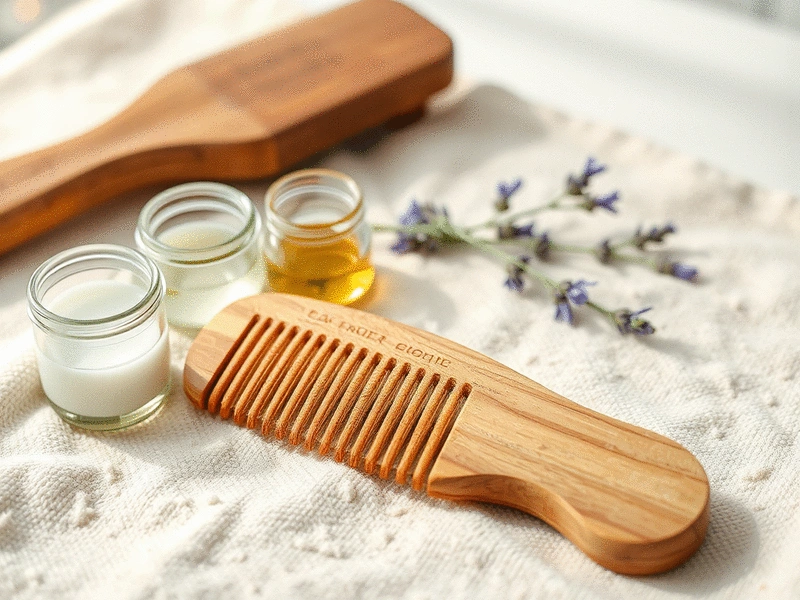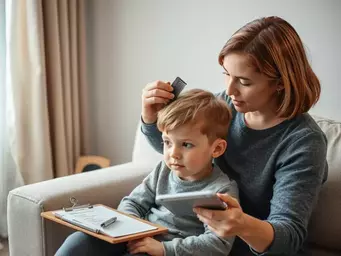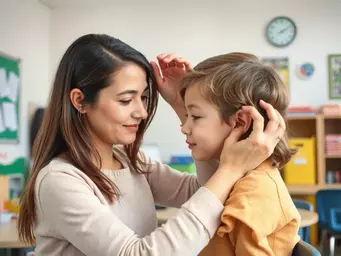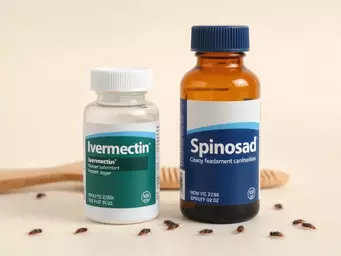Nits: Eggs firmly attached to hair shafts; hatch in ~1 week.
Effective Home Remedies for Head Lice

How would you feel if a tiny, wingless insect made itself at home on your child's scalp? For many parents, the mere mention of head lice can be anxiety-inducing. But understanding these pests can transform fear into effective action. Here’s what you need to know to tackle head lice head-on.
What You Will Learn
- Head lice spread primarily through direct head-to-head contact and sharing personal items like hats and hairbrushes.
- Common symptoms of infestation include itching, visible nits on hair shafts, and red or irritated areas on the scalp.
- Lice go through three life stages: nits (eggs), nymphs (young lice), and adults, all of which must be targeted for effective treatment.
- Natural remedies such as smothering treatments, essential oils, and wet combing can be effective in managing infestations.
- Safety considerations are crucial; always perform patch tests with new products and consult a pediatrician for sensitive skin or persistent infestations.
Understanding the Lice Life Cycle & Treatment Strategies
The visual below illustrates the distinct stages of the head lice life cycle and compares different treatment approaches, including natural remedies and their safety considerations.
Life Cycle of Lice: Nits, Nymphs, Adults
Nymphs: Young lice, mature in 7-10 days.
Adults: Mature, reproductive lice (sesame seed size).
Effective Natural Remedies & Safety Tips
Smothering: Olive/Coconut oil to suffocate lice.
Essential Oils: Tea tree, lavender for repelling.
Wet Combing: Efficient removal of lice and nits.
Safety: Patch test, consult pediatrician, pure oils.
Understanding Head Lice Infestations: A Brief Overview
When it comes to head lice, many parents feel a wave of anxiety wash over them. After all, these tiny insects can invade your child's scalp and cause quite a bit of discomfort! At Lice Nits, we aim to demystify head lice infestations and equip you with the knowledge you need to tackle this common issue.
Head lice (Pediculus humanus capitis) are small, wingless insects that live on the human scalp. They spread primarily through direct head-to-head contact, which is why they are often found in children who play closely together. While not a sign of poor hygiene, their presence can be a nuisance, leading to itching and discomfort.
What Are Head Lice and How Do They Spread?
Understanding head lice is crucial in managing an infestation effectively. These pests lay their eggs, called nits, on hair shafts close to the scalp. As they mature, they can move quickly and lay more eggs, making it essential to address an infestation promptly. Head lice spread through direct contact or by sharing personal items like hats, hairbrushes, or even headphones. The Centers for Disease Control and Prevention (CDC) provides comprehensive guidelines on preventing and controlling head lice, emphasizing the importance of understanding their transmission.
- Direct head-to-head contact is the most common way to spread lice.
- Sharing personal items can also facilitate transmission.
- Infestations can occur in schools, camps, and crowded environments.
Being aware of how lice spread can help you implement preventive measures, such as encouraging your child to avoid sharing personal items. Remember, lice do not jump or fly; they crawl from one head to another.

Common Symptoms of Head Lice Infestation
So, how do you know if your child has head lice? The first sign many parents notice is itching on the scalp, which is caused by an allergic reaction to lice bites. If your child is scratching their head more than usual, it's time to investigate further! The Mayo Clinic details these common symptoms and offers advice on diagnosis and treatment.
- Itching on the scalp, neck, and ears.
- Visible nits attached to hair shafts, particularly around the ears and neckline.
- Red or irritated areas of the scalp from scratching.
If you notice these symptoms, don’t panic! It’s essential to check your child's hair thoroughly and take appropriate action to manage the infestation.
Understanding the Life Cycle of Lice: Nits, Nymphs, and Adults
Understanding the life cycle of lice is key to effective management. Lice go through three stages: nits, nymphs, and adults. Nits are the eggs, which are typically laid close to the scalp and can be challenging to spot. They hatch into nymphs after about a week. Medical News Today offers further insights into the different stages of the lice life cycle and various treatment options.
- Nits: Eggs that are firmly attached to hair shafts. They are often yellow or white.
- Nymphs: Young lice that emerge from nits. They grow into adults in about 7-10 days.
- Adults: Mature lice that can reproduce and lay more nits. They are about the size of a sesame seed.
To effectively eliminate lice, it's vital to target all life stages. By understanding this cycle, you can take the necessary steps to ensure complete eradication of these pests.
Pro Tip
Did you know? Regularly inspecting your child's scalp and hair for signs of lice can significantly reduce the chances of a full-blown infestation. Make it a fun routine by turning it into a bonding activity—bring out the magnifying glass and see who can spot the most nits! This not only keeps you informed but also teaches your child about hygiene and prevention in an engaging way.
Frequently Asked Questions About Head Lice
Q1: What are the primary ways head lice spread?
Head lice primarily spread through direct head-to-head contact. They can also spread by sharing personal items such as hats, hairbrushes, or headphones.
Q2: What are the most common signs of a head lice infestation?
The most common signs include itching on the scalp, neck, and ears, visible nits (eggs) attached to hair shafts, and red or irritated areas on the scalp due to scratching.
Q3: What are the three life stages of head lice?
Head lice go through three life stages: nits (eggs), nymphs (young lice that hatch from nits), and adults (mature, reproductive lice).
Q4: Can natural remedies effectively treat head lice?
Yes, natural remedies such as smothering treatments (e.g., olive or coconut oil), certain essential oils (e.g., tea tree, lavender), and wet combing can be effective in managing and removing head lice.
Q5: What safety precautions should be taken when using natural head lice treatments?
It is crucial to perform a patch test for any new product, especially essential oils, to check for allergic reactions. Always consult a pediatrician if your child has sensitive skin or if the infestation persists. Use only high-quality, pure essential oils and monitor your child for any irritation or discomfort during treatment.
Key Takeaways on Head Lice Treatments
As we wrap up our discussion on head lice treatments, it’s essential to highlight some key points. Understanding the various options available can help you feel more empowered in managing lice infestations effectively. Many families have found success with natural remedies, but it’s crucial to know which ones truly work.

Based on my experience at Lice Nits, here are some effective natural remedies you might consider:
- Smothering Treatments: Olive oil and coconut oil can suffocate lice by blocking their breathing pores.
- Essential Oils: Oils like tea tree and lavender not only repel lice but may also have anti-parasitic properties.
- Wet Combing: This technique, when done correctly, can remove lice and nits efficiently, especially when combined with other remedies.
- Cetaphil: This product can be a viable option due to its unique formulation that traps lice.
Using these methods in conjunction with proper hygiene practices can significantly reduce the chances of reinfestation. Remember, every family’s situation is unique, so finding the right combination for your household is key!
Safety Considerations and Expert Recommendations
When exploring natural remedies, it’s vital to keep safety at the forefront. Although these treatments can be effective, they may also have limitations or adverse effects, particularly for young children. Always consider the following recommendations:
- Perform a patch test for any new product, especially essential oils, to ensure no allergic reactions occur.
- Consult a pediatrician if your child has sensitive skin or if the infestation persists despite treatment.
- Use only high-quality, pure essential oils, as synthetic blends may not provide the same benefits.
- Monitor your child during treatment for any signs of irritation or discomfort.
At Lice Nits, we emphasize the importance of informed choices. By doing thorough research and consulting with professionals, you can select the safest and most effective treatment options.
Engaging with Further Resources
Where to Find More Information on Lice Treatment
To continue your journey towards effective lice management, there are plenty of resources available. Websites, including Lice Nits, offer in-depth guides on various treatment options, product comparisons, and prevention strategies. Additionally, consider visiting reputable health organizations for evidence-based information and the latest research findings.
- Educational Websites: Look for platforms dedicated to health education, like Lice Nits, where you can access expert insights.
- Pediatrician Recommendations: Regularly check in with your child’s pediatrician for tailored advice and guidance.
- Community Forums: Online forums can be a great place to connect with other parents facing similar challenges, exchanging tips and experiences.
Join the Conversation: Share Your Experiences and Questions
Your voice matters! We invite you to join the discussion on head lice treatments. Have you tried any natural remedies that worked wonders for your family? Or maybe you've encountered challenges that you’d like to discuss? Sharing personal experiences not only helps you process your situation but also supports other parents facing similar challenges.
Feel free to leave your comments and questions below. At Lice Nits, we believe in the power of community and shared knowledge. Together, we can navigate this common challenge and help each other find solutions!
Recap of Key Points
Here is a quick recap of the important points discussed in the article:
- Head lice spread primarily through direct head-to-head contact and sharing personal items.
- Common symptoms of infestation include itching, visible nits, and red or irritated areas on the scalp.
- Lice have a life cycle with three stages: nits, nymphs, and adults, all of which need to be targeted for effective treatment.
- Natural remedies such as smothering treatments, essential oils, and wet combing can be effective in managing lice infestations.
- Safety considerations are essential when using treatments; always consult a pediatrician for guidance, especially for young children.
Popular Posts
 Have you ever felt the panic that arises when you discover head lice on your child's scalp? Understa
Have you ever felt the panic that arises when you discover head lice on your child's scalp? Understa
 It's surprising how easily something as small as a head louse can disrupt an entire school community
It's surprising how easily something as small as a head louse can disrupt an entire school community
 What if the key to your child's comfort and well-being lies in understanding the aftercare process f
What if the key to your child's comfort and well-being lies in understanding the aftercare process f
 What if a single application could free your family from the stress of head lice? One-dose treatment
What if a single application could free your family from the stress of head lice? One-dose treatment
